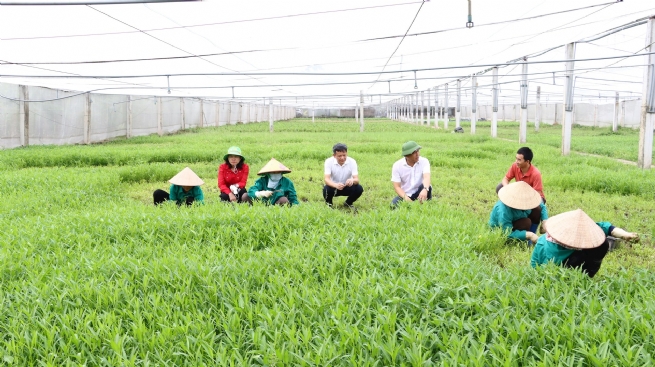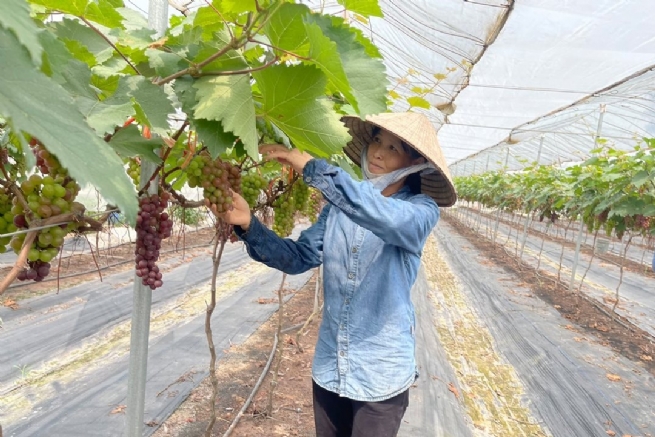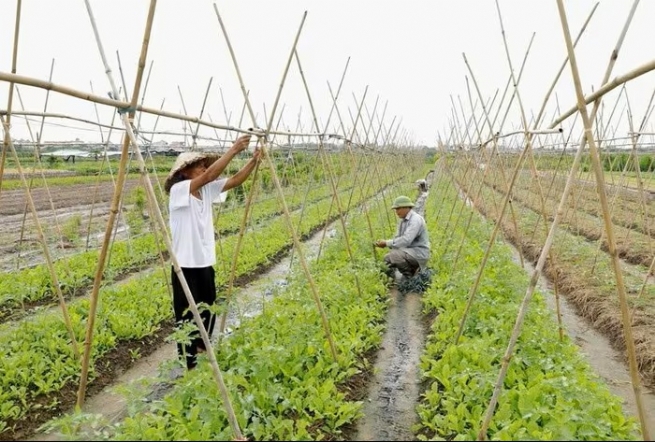Formed from eight former communes and towns, Thuong Tin Commune now spans more than 28 square kilometers and has a population exceeding 70,000. Renowned for its long-established farming traditions and extensive network of craft villages, the commune has recently introduced high-tech agricultural models and digitalized farm produce management systems. Thuong Tin is steadily emerging as a model of new-style rural development in southern Hanoi.

Promoting safe and sustainable agriculture
The commune currently has over 20 concentrated production zones covering nearly 1,200 hectares, many of which are certified under VietGAP standards or follow biosecure farming practices. Several households and cooperatives have adopted VietGAP and GlobalGAP standards, investing in temperature and humidity sensors for greenhouse cultivation and using software for digital production management and recordkeeping. According to Nguyen Van Hoa, owner of a safe vegetable farm in Hien Giang, “Thanks to standardized processes, productivity has stabilized, and selling prices are now 20-25% higher than before, with supermarkets purchasing directly.”
Aiming to develop a digital, green, and safe agricultural model, Thuong Tin is introducing electronic identification codes for each production area. Every stage, from cultivation and harvesting to preliminary processing and transportation, will be fully digitalized, enabling consumers to trace product origins with a single QR code scan. This initiative supports the goal of turning Thuong Tin into an ecological, service-oriented, and craft-based urban agricultural center in southern Hanoi, in line with the revised Capital Law and the city’s development plan through 2030 with a vision to 2050.
According to Vice Chairman of the Thuong Tin People’s Committee Nguyen Van Tan, the commune has developed several high-tech and urban agricultural models, along with linked production chains. Notable examples include the “fish in pond-river” model in Tien Phong, high-quality rice areas in Hoa Binh, Van Binh, Khanh Ha, and Hien Giang, and the safe vegetable zone in Van Phu, where gourd and luffa products have earned 3-star certification under the National One Commune, One Product (OCOP) Program and are widely distributed in and beyond Hanoi. The Nghiem Xuyen Safe Vegetable Cooperative has partnered with An Viet Food Co., Ltd. and clean agricultural store chains in Hanoi, securing stable contracts for VietGAP vegetables at prices 10–15% higher than the market average.

Building a sustainable agricultural value chain
Agricultural supply chains typically involve numerous intermediaries, mostly small traders. To create a sustainable value chain, Thuong Tin is focusing on applying science and technology to improve productivity and quality, build strong and trusted local brands, and expand distribution channels.
Local authorities play a central role in guiding and connecting value chain stakeholders. Extensive agricultural extension programs, technical training, and digital transformation initiatives in agriculture are being implemented, alongside preferential loan support, issuance of cultivation area codes, and digital traceability labels. As a result, Thuong Tin has initially developed a commune-level network of safe agricultural value chains linking producers, cooperatives, enterprises, and markets toward full process standardization.
Previously, Thuong Tin’s agricultural products were mainly sold seasonally, but linked production chains have since provided clear and stable distribution channels. Agricultural service cooperatives in Hoa Binh, Van Binh, and Van Phu have signed supply contracts with supermarkets, collective kitchens, and restaurants across the city.

Nguyen Van Tan emphasized that the commune prioritizes developing safe agricultural value chains integrated with digital technology, considering this a breakthrough in model new rural development. Each production area will be assigned an electronic identification code, and all stages from cultivation and harvesting to processing and transportation will be digitalized. By scanning a QR code, consumers can access complete information on origin, cultivation time, and quality control. Building safe agricultural value chains is not only an economic strategy but also an important contribution to rural development, environmental protection, and community well-being.
Currently, over 98% of agricultural waste in the commune is collected and treated. Waste sorting at the source and the use of organic microbial fertilizers are being widely promoted. Local cooperatives are partnering with processing enterprises to reuse agricultural by-products, reducing pollution and generating additional income. Beyond production, Thuong Tin also plans to establish a clean agricultural trading center connected online to Hanoi’s e-commerce platform, opening new market opportunities for local products. With cold storage systems, standardized preliminary processing facilities, and logistics routes under development, the Thuong Tin agricultural value chain is poised to become a model for green, digital, and safe agricultural growth, contributing to the strengthened position of Hanoi’s farm produce in the market.
By Bao Dan ,Vietnam Business Forum
|
This special section is supported by Hanoi Coordination Office of the New Rural Development Program |